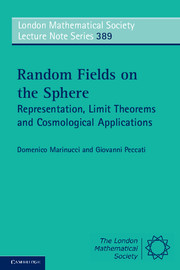Book contents
- Frontmatter
- Contents
- Preface
- 1 Introduction
- 2 Background Results in Representation Theory
- 3 Representations of SO(3) and Harmonic Analysis on S2
- 4 Background Results in Probability and Graphical Methods
- 5 Spectral Representations
- 6 Characterizations of Isotropy
- 7 Limit Theorems for Gaussian Subordinated Random Fields
- 8 Asymptotics for the Sample Power Spectrum
- 9 Asymptotics for Sample Bispectra
- 10 Spherical Needlets and their Asymptotic Properties
- 11 Needlets Estimation of Power Spectrum and Bispectrum
- 12 Spin Random Fields
- 13 Appendix
- References
- Index
9 - Asymptotics for Sample Bispectra
Published online by Cambridge University Press: 07 October 2011
- Frontmatter
- Contents
- Preface
- 1 Introduction
- 2 Background Results in Representation Theory
- 3 Representations of SO(3) and Harmonic Analysis on S2
- 4 Background Results in Probability and Graphical Methods
- 5 Spectral Representations
- 6 Characterizations of Isotropy
- 7 Limit Theorems for Gaussian Subordinated Random Fields
- 8 Asymptotics for the Sample Power Spectrum
- 9 Asymptotics for Sample Bispectra
- 10 Spherical Needlets and their Asymptotic Properties
- 11 Needlets Estimation of Power Spectrum and Bispectrum
- 12 Spin Random Fields
- 13 Appendix
- References
- Index
Summary
Introduction
As discussed in the previous chapters (see, in particular, Section 6.3), if an isotropic field is Gaussian, its dependence structure is completely identified by the angular correlation function and its harmonic transform, that is, the angular power spectrum. For non-Gaussian fields, the dependence structure becomes much richer, and higher order correlation functions are of interest. In turn, this leads to the analysis of so-called higher order angular power spectra, which we investigated in Chapter 6. Cumulant angular power spectra are identically zero for Gaussian fields, and hence they also provide natural tools to test for non-Gaussianity: this is a topic of the greatest importance in modern cosmological data analysis (see [51, 60]). Indeed, the validation of the Gaussian assumption is urged by the necessity to provide firm grounds to statistical inference on cosmological parameters, which is dominated by likelihood approaches. More importantly, tests for Gaussianity are needed to discriminate among competing scenarios for the physics of the primordial epochs: here, the currently favoured inflationary models predict (very close to) Gaussian CMB fluctuations, whereas other models yield different observational consequences (see [8, 18, 19, 20, 67, 184]). Tests for non-Gaussianity are also powerful tools to detect systematic effects in the outcome of the experiments. For these reasons, very many papers have focussed on testing for non-Gaussianity on CMB, some of them by means of topological properties of Gaussian fields, some others through spherical wavelets, or by harmonic space methods, see for instance [18, 35, 36, 37, 117, 119, 130, 164, 165, 175, 176, 198], and the references therein.
- Type
- Chapter
- Information
- Random Fields on the SphereRepresentation, Limit Theorems and Cosmological Applications, pp. 223 - 244Publisher: Cambridge University PressPrint publication year: 2011



